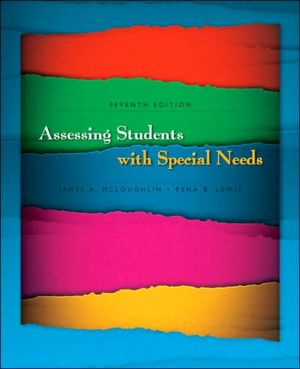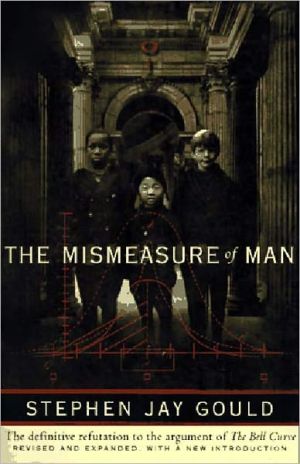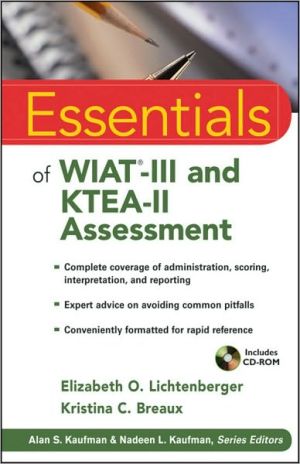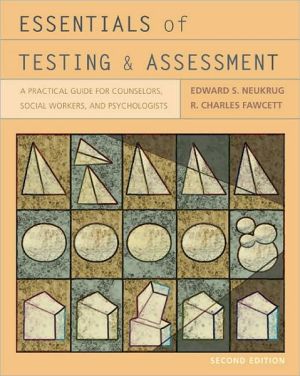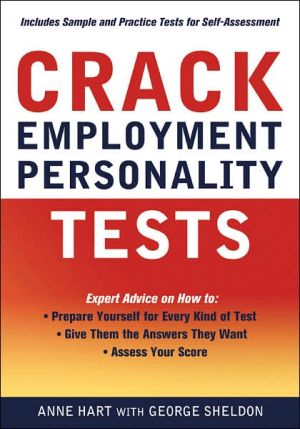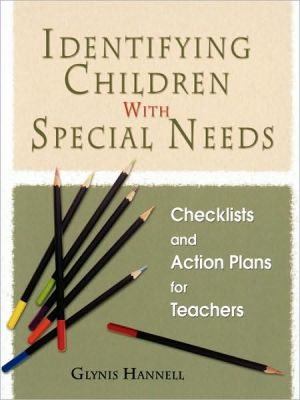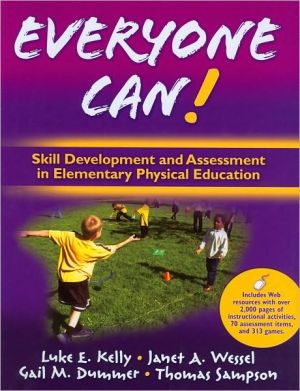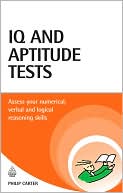Assessing Students with Special Needs
This comprehensive text for future teachers of learners with disabilities is grounded in the idea that assessment is at the center of all good teaching. Its hallmarks are its accessibility, balanced coverage of both this formal and informal assessment, plus thorough exploration of the link between gathering information and actually using it to make informed decisions. Offering a step-by-step Assessment Question Model on the inside front cover, it equips readers to understand the complete...
Search in google:
This comprehensive text for future teachers of learners with disabilities is grounded in the idea that assessment is at the center of all good teaching. Its hallmarks are its accessibility, balanced coverage of both this formal and informal assessment, plus thorough exploration of the link between gathering information and actually using it to make informed decisions. Offering a step-by-step Assessment Question Model on the inside front cover, it equips readers to understand the complete assessment process, from choosing the best tool, to adapting instruction to improving outcomes. Popular, as well as lesser-known, tools are examined in order to acquaint readers with promising procedures for assessing students with special needs.
PREFACE: \ PREFACE\ Assessment is at the center of all good teaching, and this book is designed to provide a clear, comprehensive guide to the assessment of students with mild disabilities. This book will give you an understanding of the assessment process as well as the practical skills needed to assess students with special needs successfully so that you can teach them well. To structure the process, we offer an assessment question model and we have developed the idea of the Individualized Assessment Plan (IAP). Our basis for the assessment questions and suggested procedures is a combination of best professional practices and legal mandates. This functional approach allows you sufficient flexibility to explore the areas and types of assessment in which you are particularly interested. In accordance with our belief that educators need useful information, we maintain a strong educational orientation toward assessment.\ NEW TO THE FIFTH EDITION\ This is the fifth edition of Assessing Students with Special Needs, and it reflects many changes in professional thought and practice in both special education and general education. Topics new to this edition include recent legislation (e.g., the Individuals with Disabilities Education Act Amendments), reform movements in general and special education, techniques for ongoing classroom assessment (e.g., functional assessment of behavior), test accommodations for students with disabilities, assessment for grading and report cards, evaluation of new areas of interest such as phonological processing, and the development of collaborative parent-professional partnerships in the assessment process.\ The fifth edition is organized somewhat differently from previous editions, although the content covered is the same. The entire book has been thoroughly updated with current literature and coverage of pertinent issues, trends, and professional practices. Throughout we maintain our interest in the promotion of nonbiased assessment of culturally and linguistically diverse students. Chapter 14, in particular, focuses on strategies for the assessment of students who speak dialects of English and those who speak languages other than English.\ Part One of the fifth edition, Introduction to Special Education Assessment, includes information on the purposes of assessment, laws and regulations governing assessment, the team approach to assessment, the organization of the assessment process using the assessment question model, and the steps in assessment. Part Two, Assessment Skills for Special Educators, contains chapters on selecting the tools for assessment, administration and scoring of standardized tests, and design and use of informal assessment techniques and procedures. A new chapter has also been introducedChapter 6, Classroom Assessment Techniquesand it describes a range of techniques for evaluating student progress in the classroom instructional program. These techniques include functional behavioral assessment, curriculum-based measurement, action research, and portfolio assessment. This chapter also discusses important issues in ongoing assessment such as managing student data, grading and report cards, and test accommodations.\ Part Three of the fifth edition, Assessment of General Performance Areas, centers around the general performance areas most relevant to eligibility assessment: school performance, learning aptitude, specific learning abilities and strategies, and classroom behavior. Part Four, Assessment of Academic Areas, focuses on the assessment of academic skills: reading, mathematics, written language, and oral language and bilingual assessment. Part Five, Special Considerations, provides information on three important topics: parent and family involvement in assessment, assessment during the preschool years, and assessment for transition planning.\ This edition also features new tests and assessment procedures, many of which are revised versions of measures described in earlier editions. More than 80 new published measures are included. Among the new instruments we discuss are:\ \ Peabody Individual Achievement Test-Revised/Normative Update\ Hammill Multiability Achievement Test\ Wide Range Achievement Test-Revision 3\ BRIGANCE® Diagnostic Comprehensive Inventory of Basic Skills-Revised\ Bateria Woodcock-Muñoz-Revisada\ Hammill Multiability Intelligence Test\ Test of Nonverbal Intelligence (3rd ed.)\ Scales of Independent Behavior-Revised\ Detroit Tests of Learning Aptitude (4th ed.)\ Developmental Test of Visual Perception (2nd ed.)\ Developmental Test of Visual Motor Integration (4th ed.)\ Conners' Rating ScalesRevised\ Child Behavior Checklist\ The Instructional Environment Scale-II\ Comprehensive Test of Phonological Processing\ Test of Reading Comprehension (3rd ed.)\ Woodcock Reading Mastery\ Tests-Revised/Normative Update\ Monitoring Basic Skills Progress\ KeyMath Revised/Normative Update\ Stanford Diagnostic Mathematics Test (4th ed.)\ Test of Mathematical Abilities (2nd ed.)\ Mather-Woodcock Group Writing Tests\ Oral and Written Language Scales\ Test of Adolescent and Adult Language-3\ Test of Written Language-3\ Test of Written Spelling-4\ Test of Language Development-3, Primary and Intermediate\ Peabody Picture Vocabulary Test, Third Edition\ Comprehensive Receptive and Expressive Vocabulary Test\ Assessment, Evaluation, and Programming System for Infants and Children\ Hawaii Early Learning Profile\ BRIGANCE® Employability Skills Inventory\ Transition Planning Inventory\ \ FEATURES\ Our goal in this book is to provide you with a foundation for understanding the assessment process and with the skills necessary for carrying out meaningful assessments. The chief strength of this text remains its balanced coverage of formal and informal assessment. Critiques of the strengths and weaknesses of formal tests and informal procedures help you to select the tools that will supply the information you need.\ We have chosen to speak about popular assessment procedures as well as less well known, but distinctive, measures. Popular instruments are discussed in some depth, not necessarily because they are always the best techniques, but because they reflect current practice. On the other hand, information about less well known tests and techniques is provided to acquaint you with promising procedures. With this comprehensive coverage, you will find out not only what is currently being done (and how well) but also what needs to be changed and how to do that.\ In addition, we provide the connection between gathering assessment information and using it to make decisions. There are regular reminders to consider assessment data in relation to the classroom setting and suggestions for making sense out of all the information gathered. This process is described in the context of a team approach to educational assessment but with particular emphasis on the role of the special education teacher.\ To make our book a more practical classroom resource, we have included several useful case reports, sample test profiles, checklists, and illustrations. Also, information boxes throughout the chapters summarize the important characteristics of tests discussed in depth. We have tried to give you a feel for the procedures you will use in assessment and to critique and relate them to one another so that you can better understand how to use them. Each chapter begins with a brief topical outline of its contents and ends with a Study Guide containing factual review questions, applied activities, and discussion questions focusing on critical issues addressed in the chapter.\ Companion Website\ A companion website is available for both students and professors. Students can take self-quizzes and submit their responses online to the professor as well as view their scores and obtain page references in the text for answers to questions marked incorrect. Students also have access to chat rooms and bulletin boards for peer discussion. Instructors will have a Syllabus Builder which allows them to develop and customize a syllabus for their course. The address of the companion website for Assessing Students with Special Needs is: ...
PART I. INTRODUCTION TO SPECIAL EDUCATION ASSESSMENT. 1. Special Education Assessment. 2. The Assessment Process. PART II: ASSESSMENT SKILLS FOR SPECIAL EDUCATORS. 3. Selection of Assessment Tools. 4. Standardized Tests. 5. Informal Assessment. 6. Curriculum-Based Classroom Assessment Techniques. PART III: ASSESSMENT OF GENERAL PERFORMANCE AREAS. 7. School Performance. 8. Learning Aptitude. 9. Specific Learning Abilities and Strategies. 10. Classroom Behavior. PART IV: ASSESSMENT OF ACADEMIC AREAS. 11. Reading. 12. Mathematics. 13. Written Language. 14. Oral Language and Bilingual Assessment. PART V: SPECIAL CONSIDERATIONS. 15. Parent and Family Involvement, Eleanor W. Lynch. 16. Early Childhood Assessment, Laura J. Hall. 17. Assessment for Transition Education and Planning, John R. Johnson. Answers to Review Questions. Glossary. References. Author Index. Subject Index.
